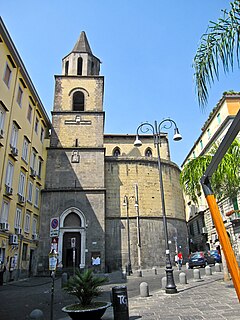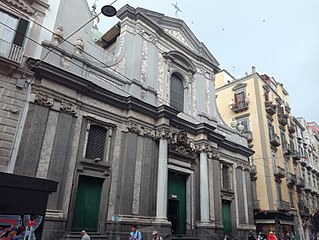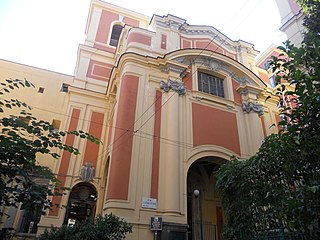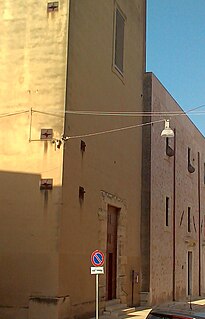
The Basilica of San Domenico is one of the major churches in Bologna, Italy. The remains of Saint Dominic, founder of the Order of Preachers (Dominicans), are buried inside the exquisite shrine Arca di San Domenico, made by Nicola Pisano and his workshop, Arnolfo di Cambio and with later additions by Niccolò dell'Arca and the young Michelangelo.

Santa Maria la Nova is a Renaissance style, now-deconsecrated, Roman Catholic church and monastery in central Naples. The church is located at the beginning of a side street directly across from the east side of the main post office, a few blocks south of the Church and Monastery of Santa Chiara. Today the adjacent monastery is a meeting site and hosts the Museo ARCA of modern religious art.

San Pietro Martire is a Roman Catholic church in Naples, Italy. It is located directly across from the principal building of the University of Naples on the main street, Corso Umberto corner with Via Porta di Massa, near the port area. In the piazza in front of the church is a statue of Ruggero Bonghi.

San Pietro a Majella is a church in Naples, Italy. The term may also refer to the adjacent Naples music conservatory, which occupies the premises of the monastery that used to form a single complex with the church.

The Basilica of Saint Nicolas of Tolentino is a Roman Catholic church and minor basilica that is part of the Augustinian monastery in the hill-town of Tolentino, province of Macerata, Marche, central Italy. The church is a former cathedral of the Roman Catholic Diocese of Tolentino, suppressed in 1586.

San Francesco della Vigna is a Roman Catholic church in the Sestiere of Castello in Venice, northern Italy.

Pistoia Cathedral is the main religious building of Pistoia, Tuscany, central Italy, located in the Piazza del Duomo in the centre of the city. It is the seat of the Bishop of Pistoia and is dedicated to Saint Zeno of Verona.

The Abbey of Santa Giustina is a 10th-century Benedictine abbey complex located in front of the Prato della Valle in central Padua, region of Veneto, Italy. Adjacent to the former monastery is the basilica church of Santa Giustina, initially built in the 6th century, but whose present form derives from a 17th-century reconstruction.

Volterra Cathedral is a Roman Catholic cathedral in Volterra, Italy, dedicated to the Assumption of the Virgin Mary. It is the seat of the bishop of Volterra.

The church of St. Nicholas the Charitable is a church located on via Toledo, almost midway between Piazza Carità and Piazza Dante in Naples, Italy.

Santo Domingo Church, formally known as the National Shrine of Our Lady of the Holy Rosary of La Naval de Manila, is the largest church in Metro Manila and one of the biggest churches in Asia. It is dedicated to Mary, mother of Jesus under her title Our Lady of La Naval de Manila.

The church of Santa Caterina da Siena is located in the city center of Naples, Italy, and while built in the 16th century, the interior was decorated by Baroque era artists over the next two centuries.

The Basilica of Santa Maria Assunta is a 14th-century basilica in Alcamo, province of Trapani, Sicily, southern Italy. It is named after the Assumption.

Santi Paolo e Bartolomeo is a 17th-century baroque style church located in Alcamo, in the province of Trapani, Sicily, southern Italy.

Avellino Cathedral is a Roman Catholic cathedral dedicated to the Assumption of the Virgin Mary and Saint Modestinus in Avellino, Campania, Italy. It is the seat of the bishops of Avellino.

San Francesco is Gothic-style, Roman Catholic, church in a piazza of the same name in the town of San Gemini, region of Umbria, Italy. The 13-14th-century church was erected by the Franciscan order and dedicated to St Francis, who visited the town at least twice in his lifetime.

The Co-Cathedral of Saint Mary of the Assumption and Saint Catellus is the Roman Catholic duomo or cathedral of Castellammare di Stabia in the metropolitan city of Naples, in the region of Campania, Italy. It is the main church in Castellammare di Stabia and it is co-cathedral of the Archdiocese of Sorrento-Castellammare. It was built in 1587 and was consecrated in 1893. Inside on display for worship is the statue of Saint Catello, the patron saint of the city.

Badia Nuova is a Catholic church located in Alcamo, in the province of Trapani, Sicily, southern Italy.

Santissimo Crocifisso is a Catholic church in Alcamo, in the province of Trapani, Sicily, southern Italy.
San Biagio is Roman Catholic church and monastery in the municipality of Aversa, province of Caserta, in the region of Campania, southern Italy.




















